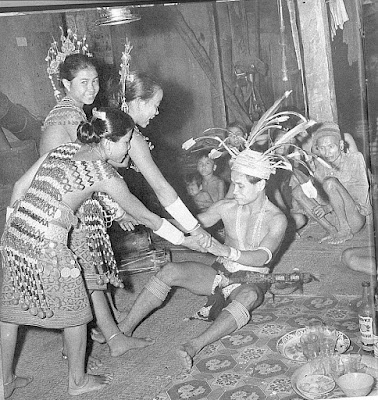Dikelala bungai ari kayu,
Dikelala buah ari langgu,
Dikelala bansa ari jaku,
Dikelala adat ari penyiru,
Dikelala kaban ari ngepan.
The Land of Hornbills recently
witnessed one of the grandest weddings in Sarawak history. It was the wedding
of the great grand-daughter of Tun Jugah, Ms. Amanda Sura Nanta Linggi to Mr.
Jonathan Inggit Jacques which was solemnised on 29 June 2017 in Kuching,
Sarawak. The solemnisation then continued with two receptions held in Kuching
and Kapit.
 |
Tun Temenggong Jugah Anak Barieng or Tun Jugah (1903 – July 1981)
was a Malaysian politician of Iban descent from the state of Sarawak. |
Apart from being the wedding of
the late Tun Jugah’s great grand-daughter, it was one of the weddings held with
spectacular Iban regalia complete with age old 'adat' or custom. However, what
interests me the most was her two wedding costumes worn during the receptions,
finally, someone is wearing something old (despite modern modifications) other
than ngepan Rawai Tinggi Saribas.
At the first glance they looked like the
traditional Iban woman costumes of Batang Rajang, in which, Carnelian,Venetian and glass beads threaded to form the “dress” apart from the skirt called “kain burik”. Many were commenting
about the origin of the costumes as they have never seen them before (unless
you are familiar with the Iban Rajang costume).
Yes, ladies and gentlemen, that
ngepan does exist, ari Batang Rajang penatai ngepan nya.
I managed to have a quick chat
with the Ms. Amanda to discover the origin of her ngepan. Definitely both of her
ngepan were inspired by the traditional ngepan Iban Rajang as they were
modification from something traditional. Her first traditional reception ngepan
was inspired by the baju marik which would normally be donned with the “dujung
marik” as the headgear.
As for the Kapit reception, she
wore the pearl vest which was also inspired by a different version of ngepan
Iban Rajang. I was informed that it took her aunt and the ladies of the Tun
Jugah Foundation five months to thread both ngepan. Other than the beaded
dresses, she also donned authentic sugu tinggi pirak (silver filigree headgear),
rawai pandak (short corset) and kain burik (skirt made out of cowrie shells) passed
down by her grandmother.



Upon the uploading of the bride's photos in her modern ngepan Batang Rajang, Facebook was not short of negative comments given by netizens stating that such costumes do not exist. This problem occurs because there is lack of awareness and knowledge plus humans are always attracted to fault finding.
Some were questioning whether it
is allowed to wear the “modified” version of the original ngepan. As for me, I
am not against such modifications as it is for a wedding after all and not for
a traditional costume competition. Modifications made to the costume is fine
for me, however I am more particular about the purpose and the ‘correctness’ of
accessories being placed on the body while wearing it.
In conclusion, wearing the traditional ngepan is one of the ways for us to preserve our dying culture. It is our hope that the younger generation would proud of their culture by embracing it through practice and finding the history behind the culture.
Last but not least I would like to give credit to Andy Phe for sharing his photos in FB and other FB users too.
"Fashion is not something that exists in dresses only. Fashion is in the sky, in the street, fashion has to do with ideas, the way we live, what is happening" - Coco Chanel

















































